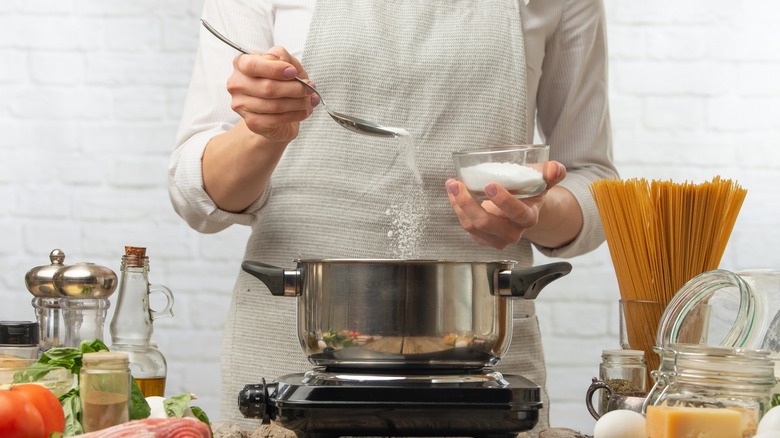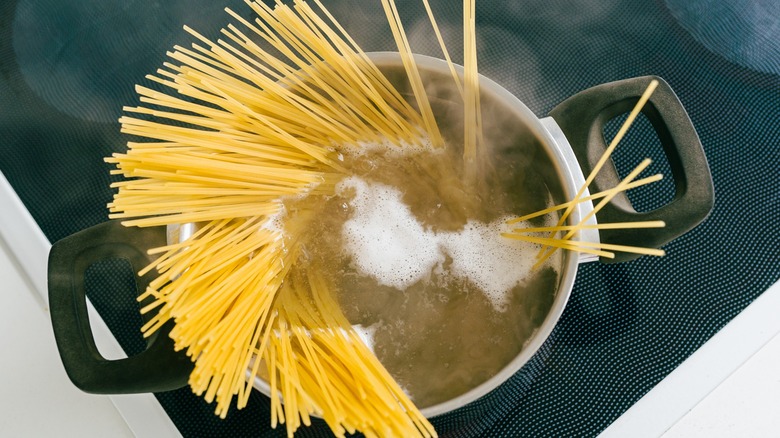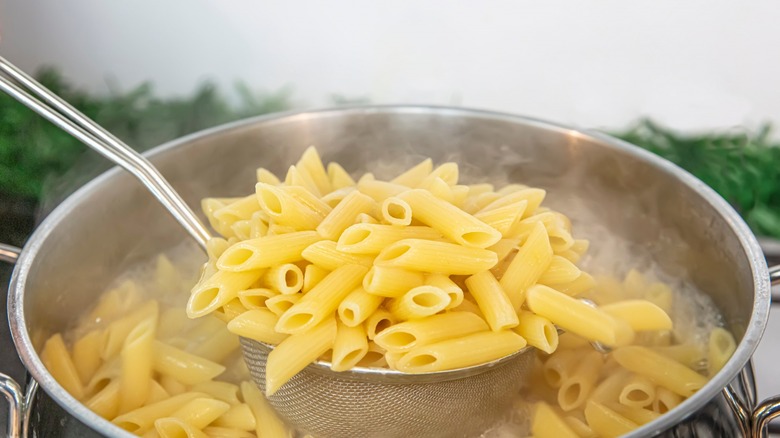Here's What Properly Salted Pasta Water Should Taste Like
Salting the water you boil your pasta in is one of the simplest tasks you can do in a kitchen, but it's important to remember that you don't have to be stingy about it. Pasta is usually completely bland with no added seasoning, and even though you'll get a chance to spice it up with whatever sauce is dolloped on top, it's best to at least coat it with a base layer of flavor. Of course, taste buds are a chef's best asset; you can always have a sip of pasta water to make sure that it's well-seasoned.
Nonnas the world over may say that pasta water should be "as salty as the sea," although this isn't exactly true. Remember that you still want to be able to lightly drink the water without gagging, and if you've ever accidentally swallowed a mouthful of ocean, you know it's not a culinary experience. Putting that much salt in a pot of water is a great way of making your pasta unpalatable, and it requires pouring most of your kitchen's salt out, anyway. Instead, Nonna's adage is an exaggeration to express a very true observation: most people don't salt their pasta enough. Ideally, pasta water should taste like a nice soup broth, which requires a fairly decent amount of salt.
Why pasta water should be salty
Part of the reason why boiled pasta requires a liberal dosage of salt is that most of it will get poured down the drain, anyway. In reality, pasta will only absorb about a quarter of the salt added to a pot of water; the rest of it dissolves into the solution. Recipes and cooking guides have slightly varying advice on salt-to-water ratio, but the best general optimal conditions are about 2% salinity, which roughly translates to about a tablespoon or slightly less of salt for every quart of water.
Lots of people also have the misconception that salt helps water boil faster. The truth is that adding salt to a pot on the stove isn't going to save any time, and can actually raise the boiling point slightly. Rather, adding salt to water is a way to flavor it, not speed up cooking. In fact, it's best to pour in salt right after the water has come to a boil already so it dissolves more easily. Also, keep in mind the type of sauce you'll eventually cover the pasta in. If it's a particularly salty topping, say one that involves bacon, anchovies, or Parmesan, you may want pre-salt the water slightly less.
Types of salt to use
The quality of boiled pasta will also come down to the type of salt you're using. The finer the grains, the more easily they will dissolve into the water. That means that if you're using Kosher salt, which usually has coarser grains than sea or table salt, you'll probably need a bigger serving. So if you're using Morton kosher salt, you'll need about a tablespoon and a half. In addition, you'll need to up the dosage with the flakier (ironically less crystalline) Diamond Crystal to about two tablespoons.
Some people enjoy the metallic, saltier taste of iodine, but restaurant chefs almost always use pure Kosher salt in their recipes. Sea salt will have additional minerals that can also impact the taste of your food, though these tend to be milder than the harsh sting of iodized salt. Sea salts can be more expensive than Kosher salt, though, and since most of the salt isn't even going to coat the pasta, it may be a more frugal idea to use a cheaper option. If you're ever in doubt about your pasta water, just give it a taste. If there's too much salt, you can just toss it and start over, but chances are you'll almost always need to add more.



